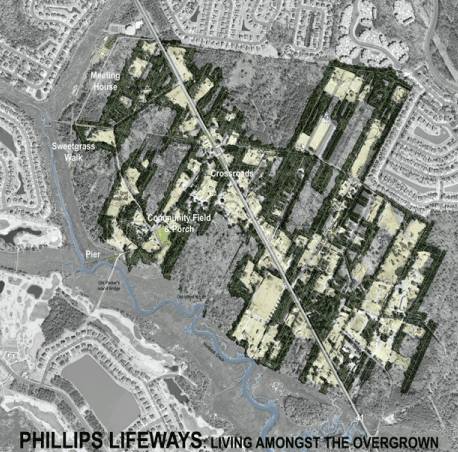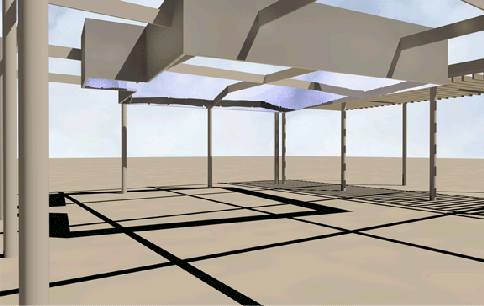A few months ago in Fort Lauderdale, landscape architect, Walter Hood of Oakland, California, present his work. Never heard of him, but the Design Arts speakers had been excellent at Broward County Cultural Affairs in the last few years.
Hood sticks with me. Especially his recognition of the “overgrown” from the people on the Phillips community near Charleston, South Carolina. According to my memory of his talk, overgrown became a noun – the overgrown. Instead of an unkempt and unweeded outdoor place where vines and other plants cover-up up the garden or the collapsed building, in this rural landscape the overgrown was the thick, green stuff that made the edges of property. The overgrown expanded naturally providing more protection and was cut back when the owner need more space and I guess less protection.

Phillips Site Plan. Drawing by Walter Hood.
In reverse of the suburban openness, each family lives in a giant green room that is furnished with a house, outbuildings, automobiles and gardens. Walls of the room expand and contract through the interaction of the humans and the overgrown. Decades long time-lapsed photography might resemble a slowly beating heart. (See note on overgrown at bottom for the desert and plains dwellers)
What I felt through Hood’s interpretation was a community wide language expressing a psychological state through spatial form. In literature and garden design, overgrowth has been a romantic, emotional metaphor of life in death. But here the overgrown is straightforward outcome of family health. New young adults or the determined aged patriarch keep the overgrown shallow and the space open. The thick overgrown hides the exhausted working single mom or alcoholic dad.
If I recall correctly, part of Hood’s proposal was to clear part of the overgrown for a community meeting place. A direct choice that has more power with his observation. Or does it? Can these narratives be art?
Hood has designed a garden on top of the archeological site of the Foster Homestead at the University of Virginia. This is not a community setting, but an institutional setting where visitors will be told about the African-American family history forgotten and now recovered. His “Shadowcatcher” suspends an outline of foundation of the lost house in a Cartesian grid high above the archeological dig. (Cartesian for surveying America and for cataloguing a dig). As an image above our heads we have reference to heaven or to flying spirits of the dead. As a shadow on the ground, we have the purity of platonic form and the memory lightly marked on the sacred or archeological space.

Shadowcatcher at Foster Homestead. Drawing by Walter Hood.
The work is a diagram of ideas and references. In the 1960s or 1970s Venturi made white drawing in space of Ben Franklin’s house on the spot of Franklin’s house in Philadelphia. Venturi makes no other references – just a pop icon of a 3D outline that marks the spot.
Many other contemporary installations draw the thing below on the ground like the former water edge of the natural harbor or the culverted stream. Rebuilding a one or two stone high foundations is typical of archaeological tourist sites in every country.
Like so many others of contemporary public art, Hood invents from the known experience to diagram literal narrative. Will the visitor really look at the floating foundation and find something unknown in the descriptive words? Will the floating foundation be a magical transformation of a typical one or two stone high ground level re-creation?
Leaving forms in the literal can never reach a complexity that I desire in my art. Making only the smart, respectable choice is not the same as artistic celebration. During careless, thoughtless days of modernism, just doing the right thing was a dramatic success that the public artist frequently brought to public space. Just doing the right thing is no longer enough for me.
Someday, I look forward to visiting Hood’s completed projects in California. I think I will learn something entirely different.
Footnote: The Overgrown
For those you unfamilar with carving space from a forest in a wet, warm climate, the overgrown forms quickly at the cut edge from young trees, bushes and vines. The mature forest or stand of mature trees grows very little on the floor until a trees falls, letting in the sunlight. The forest is generally easier to walk through than the edge. So it is the overgrown at the edge makes the enclosure and protection. Normally on both the farm and suburb, the overgrown is cut to stop the loss of “useable” land and to maintain a visually open feeling into the forest.
Public Art, Public Space
